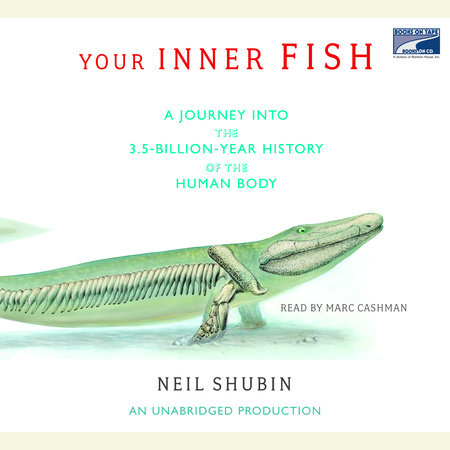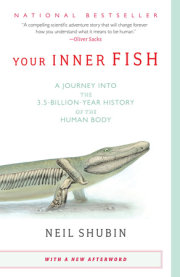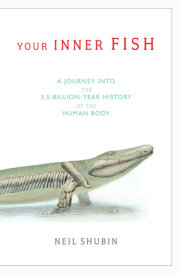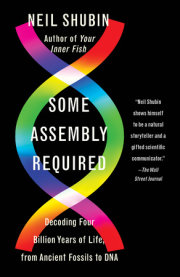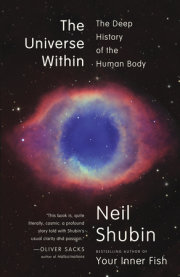FINDING YOUR INNER FISHTypical summers of my adult life are spent in snow and sleet, cracking rocks on cliffs well north of the Arctic Circle. Most of the time I freeze, get blisters, and find absolutely nothing. But if I have any luck, I find ancient fish bones. That may not sound like buried treasure to most people, but to me it is more valuable than gold.
Ancient fish bones can be a path to knowledge about who we are and how we got that way. We learn about our own bodies in seemingly bizarre places, ranging from the fossils of worms and fish recovered from rocks from around the world to the DNA in virtually every animal alive on earth today. But that does not explain my confidence about why skeletal remains from the past—and the remains of fish, no less—offer clues about the fundamental structure of our bodies.
How can we visualize events that happened millions and, in many cases, billions of years ago? Unfortunately, there were no eyewitnesses; none of us was around. In fact, nothing that talks or has a mouth or even a head was around for most of this time. Even worse, the animals that existed back then have been dead and buried for so long their bodies are only rarely preserved. If you consider that over 99 percent of all species that ever lived are now extinct, that only a very small fraction are preserved as fossils, and that an even smaller fraction still are ever found, then any attempt to see our past seems doomed from the start.
DIGGING FOSSILS—SEEING OURSELVESI first saw one of our inner fish on a snowy July afternoon while studying 375-million-year-old rocks on Ellesmere Island, at a latitude about 80 degrees north. My colleagues and I had traveled up to this desolate part of the world to try to discover one of the key stages in the shift from fish to land-living animals. Sticking out of the rocks was the snout of a fish. And not just any fish: a fish with a flat head. Once we saw the flat head we knew we were onto something. If more of this skeleton were found inside the cliff, it would reveal the early stages in the history of our skull, our neck, even our limbs.
What did a flat head tell me about the shift from sea to land? More relevant to my personal safety and comfort, why was I in the Arctic and not in Hawaii? The answers to these questions lie in the story of how we find fossils and how we use them to decipher our own past.
Fossils are one of the major lines of evidence that we use to understand ourselves. (Genes and embryos are others, which I will discuss later.) Most people do not know that finding fossils is something we can often do with surprising precision and predictability. We work at home to maximize our chances of success in the field. Then we let luck take over.
The paradoxical relationship between planning and chance is best described by Dwight D. Eisenhower’s famous remark about warfare: “In preparing for battle, I have found that planning is essential, but plans are useless.” This captures field paleontology in a nutshell. We make all kinds of plans to get us to promising fossil sites. Once we’re there, the entire field plan may be thrown out the window. Facts on the ground can change our best-laid plans.
Yet we can design expeditions to answer specific scientific questions. Using a few simple ideas, which I’ll talk about below, we can predict where important fossils might be found. Of course, we are not successful 100 percent of the time, but we strike it rich often enough to make things interesting. I have made a career out of doing just that: finding early mammals to answer questions of mammal origins, the earliest frogs to answer questions of frog origins, and some of the earliest limbed animals to understand the origins of land-living animals.
In many ways, field paleontologists have a significantly easier time finding new sites today than we ever did before. We know more about the geology of local areas, thanks to the geological exploration undertaken by local governments and oil and gas companies. The Internet gives us rapid access to maps, survey information, and aerial photos. I can even scan your backyard for promising fossil sites right from my laptop. To top it off, imaging and radiographic devices can see through some kinds of rock and allow us to visualize the bones inside.
Despite these advances, the hunt for the important fossils is much what it was a hundred years ago. Paleontologists still need to look at rock—literally to crawl over it—and the fossils within must often be removed by hand. So many decisions need to be made when prospecting for and removing fossil bone that these processes are difficult to automate. Besides, looking at a monitor screen to find fossils would never be nearly as much fun as actually digging for them.
What makes this tricky is that fossil sites are rare. To maximize our odds of success, we look for the convergence of three things. We look for places that have rocks of the right age, rocks of the right type to preserve fossils, and rocks that are exposed at the surface. There is another factor: serendipity. That I will show by example.
Our example will show us one of the great transitions in the history of life: the invasion of land by fish. For billions of years, all life lived only in water. Then, as of about 365 million years ago, creatures also inhabited land. Life in these two environments is radically different. Breathing in water requires very different organs than breathing in air. The same is true for excretion, feeding, and moving about. A whole new kind of body had to arise. At first glance, the divide between the two environments appears almost unbridgeable. But everything changes when we look at the evidence; what looks impossible actually happened.
In seeking rocks of the right age, we have a remarkable fact on our side. The fossils in the rocks of the world are not arranged at random. Where they sit, and what lies inside them, is most definitely ordered, and we can use this order to design our expeditions. Billions of years of change have left layer upon layer of different kinds of rock in the earth. The working assumption, which is easy to test, is that rocks on the top are younger than rocks on the bottom; this is usually true in areas that have a straightforward, layer-cake arrangement (think the Grand Canyon). But movements of the earth’s crust can cause faults that shift the position of the layers, putting older rocks on top of younger ones. Fortunately, once the positions of these faults are recognized, we can often piece the original sequence of layers back together.
The fossils inside these rock layers also follow a progression, with lower layers containing species entirely different from those in the layers above. If we could quarry a single column of rock that contained the entire history of life, we would find an extraordinary range of fossils. The lowest layers would contain little visible evidence of life. Layers above them would contain impressions of a diverse set of jellyfish-like things. Layers still higher would have creatures with skeletons, appendages, and various organs, such as eyes. Above those would be layers with the first animals to have backbones. And so on. The layers with the first people would be found higher still. Of course, a single column containing the entirety of earth history does not exist. Rather, the rocks in each location on earth represent only a small sliver of time. To get the whole picture, we need to put the pieces together by comparing the rocks themselves and the fossils inside them, much as if working a giant jigsaw puzzle.
That a column of rocks has a progression of fossil species probably comes as no surprise. Less obvious is that we can make detailed predictions about what the species in each layer might actually look like, by comparing them with species of animals that are alive today; this information helps us to predict the kinds of fossils we will find in ancient rock layers. In fact, the fossil sequences in the world’s rocks can be predicted by comparing ourselves with the animals at our local zoo or aquarium.
How can a walk through the zoo help us predict where we should look in the rocks to find important fossils? A zoo offers a great variety of creatures that are all distinct in many ways. But let’s not focus on what makes them distinct; to pull off our prediction, we need to focus on what different creatures share. We can then use the features common to all species to identify groups of creatures with similar traits. All the living things can be organized and arranged like a set of Russian nesting dolls, with smaller groups of animals comprised in bigger groups of animals. When we do this, we discover something very fundamental about nature.
Every species in the zoo and the aquarium has a head and two eyes. Call these species “Everythings.” A subset of the creatures with a head and two eyes has limbs. Call the limbed species “Everythings with limbs.” A subset of these headed and limbed creatures has a huge brain, walks on two feet, and speaks. That subset is us, humans. We could, of course, use this way of categorizing things to make many more subsets, but even this threefold division has predictive power.
The fossils inside the rocks of the world generally follow this order, and we can put it to use in designing new expeditions. To use the example above, the first member of the group “Everythings,” a creature with a head and two eyes, is found in the fossil record well before the first “Everything with limbs.” More precisely, the first fish (a card-carrying member of the “Everythings”) appears before the first amphibian (an “Everything with limbs”). Obviously, we refine this by looking at more kinds of animals and many more characteristics that groups of them share, as well as by assessing the actual age of the rocks themselves.
In our labs, we do exactly this type of analysis with thousands upon thousands of characteristics and species. We look at every bit of anatomy we can, and often at large chunks of DNA. There are so much data that we often need powerful computers to show us the groups within groups. This approach is the foundation of biology, because it enables us to make hypotheses about how creatures are related to one another.
Besides helping us refine the groupings of life, hundreds of years of fossil collection have produced a vast library, or catalogue, of the ages of the earth and the life on it. We can now identify general time periods when major changes occurred. Interested in the origin of mammals? Go to rocks from the period called the Early Mesozoic; geochemistry tells us that these rocks are likely about 210 million years old. Interested in the origin of primates? Go higher in the rock column, to the Cretaceous period, where rocks are about 80 million years old.
The order of fossils in the world’s rocks is powerful evidence of our connections to the rest of life. If, digging in 600-million-year-old rocks, we found the earliest jellyfish lying next to the skeleton of a woodchuck, then we would have to rewrite our texts. That woodchuck would have appeared earlier in the fossil record than the first mammal, reptile, or even fish—before even the first worm. Moreover, our ancient woodchuck would tell us that much of what we think we know about the history of the earth and life on it is wrong. Despite more than 150 years of people looking for fossils—on every continent of earth and in virtually every rock layer that is accessible—this observation has never been made.
Let’s now return to our problem of how to find relatives of the first fish to walk on land. In our grouping scheme, these creatures are somewhere between the “Everythings” and the “Everythings with limbs.” Map this to what we know of the rocks, and there is strong geological evidence that the period from 380 million to 365 million years ago is the critical time. The younger rocks in that range, those about 360 million years old, include diverse kinds of fossilized animals that we would all recognize as amphibians or reptiles. My colleague Jenny Clack at Cambridge University and others have uncovered amphibians from rocks in Greenland that are about 365 million years old. With their necks, their ears, and their four legs, they do not look like fish. But in rocks that are about 385 million years old, we find whole fish that look like, well, fish. They have fins, conical heads, and scales; and they have no necks. Given this, it is probably no great surprise that we should focus on rocks about 375 million years old to find evidence of the transition between fish and land-living animals.
We have settled on a time period to research, and so have identified the layers of the geological column we wish to investigate. Now the challenge is to find rocks that were formed under conditions capable of preserving fossils. Rocks form in different kinds of environments and these initial settings leave distinct signatures on the rock layers. Volcanic rocks are mostly out. No fish that we know of can live in lava. And even if such a fish existed, its fossilized bones would not survive the superheated conditions in which basalts, rhyolites, granites, and other igneous rocks are formed. We can also ignore metamorphic rocks, such as schist and marble, for they have undergone either superheating or extreme pressure since their initial formation. Whatever fossils might have been preserved in them have long since disappeared. Ideal to preserve fossils are sedimentary rocks: limestones, sandstones, siltstones, and shales. Compared with volcanic and metamorphic rocks, these are formed by more gentle processes, including the action of rivers, lakes, and seas. Not only are animals likely to live in such environments, but the sedimentary processes make these rocks more likely places to preserve fossils. For example, in an ocean or lake, particles constantly settle out of the water and are deposited on the bottom. Over time, as these particles accumulate, they are compressed by new, overriding layers. The gradual compression, coupled with chemical processes happening inside the rocks over long periods of time, means that any skeletons contained in the rocks stand a decent chance of fossilizing. Similar processes happen in and along streams. The general rule is that the gentler the flow of the stream or river, the better preserved the fossils.
Copyright © 2008 by Neil Shubin. All rights reserved. No part of this excerpt may be reproduced or reprinted without permission in writing from the publisher.

